Plant Growth Regulators for the Cultivation and Vase Life of Geophyte Flowers and Leaves
Abstract
1. Introduction
2. Plant Growth Regulators (PGRs) Used in Geophytes
2.1. Gibberellins (GAs)
2.1.1. Mechanism of GA Action
2.1.2. The Effect of Gas on Flowering and Quality of Geophytes
2.2. Cytokinins (CKs)
2.2.1. Mechanism of CK Action
2.2.2. The Effect of CKs on Flowering and Quality of Geophytes
2.3. Effect of a Mixture of CKs and GAs on Flowering and Plant Quality of Geophytes
2.4. Auxins
Effect of Auxins on Flowering and Quality of Geophytes
3. Vase Life of Geophyte Flowers
4. Vase Life of Geophyte Leaves
5. Conclusions
Author Contributions
Funding
Institutional Review Board Statement
Data Availability Statement
Conflicts of Interest
References
- Raunkiaer, C. The Life Forms of Plants and Statistical Plant Geography; Oxford University Press: London, UK, 1934. [Google Scholar]
- Rundel, P.W. Monocotyledonous geophytes in the California flora. Madroño 1996, 43, 355–368. [Google Scholar]
- Hoffmann, A.J.; Liberona, F.; Hoffmann, E.A. Distribution and ecology of geophytes in Chile. Conservation threats to geophytes in Mediterranean-type regions. In Landscape Disturbance and Biodiversity in Mediterranean-Type Ecosystems; Rundel, P.W., Montenegro, G., Jaksic, F.M., Eds.; Springer Nature: New York, NY, USA, 1998; pp. 231–253. [Google Scholar]
- Parsons, R.F.; Hopper, S.D. Monocotyledonous geophytes: Comparison of south-western Australia with other areas of mediterranean climate. Aust. J. Bot. 2003, 51, 129–133. [Google Scholar] [CrossRef]
- Procheş, Ş.; Cowling, R.M.; Goldblatt, P.; Manning, J.C.; Snijman, D.A. An overview of the Cape geophytes. Biol. J. Linn. Soc. 2006, 87, 27–43. [Google Scholar] [CrossRef]
- Bryan, J.E. Bulbs; Timber Press: Portland, OR, USA, 1989. [Google Scholar]
- Genders, R. Bulbs, a Complete Handbook of Bulbs, Corms and Tubers; Robert Hale and Company: London, UK, 1973. [Google Scholar]
- Mathew, B. Dwarf Bulbs; B.T. Batsford Limited: London, UK, 1973. [Google Scholar]
- Mathew, B. The Larger Bulbs; Batsford Limited: London, UK, 1978. [Google Scholar]
- Halevy, A.H. Recent advances in control of flowering, and growth habit of geophytes. Acta Hortic. 1990, 266, 35–42. [Google Scholar] [CrossRef]
- Sochacki, D.; Rabiza-Świder, J.; Skutnik, E. Ozdobne Rośliny Cebulowe–Produkcja i Zastosowaniem; Katedra Roślin Ozdobnych, SGGW: Warszawa, Poland, 2018; p. 5. [Google Scholar]
- Rademacher, W. Plant growth regulators: Backgrounds and uses in plant production. J. Plant Growth Regul. 2015, 34, 845–872. [Google Scholar] [CrossRef]
- Sathyanarayana, E.; Divya, K. Role of plant growth regulators in flower crops. In Advances in Horticulture; Lodhi, S.K., Kumar, V., Eds.; AkiNik Publications: New Delhi, India, 2021; pp. 3–15. [Google Scholar]
- Grzesik, M. Factors influencing the effectiveness of growth regulators in nursery production. Acta Hort. 1989, 251, 371–375. [Google Scholar] [CrossRef]
- Carey, D.J.; Whipker, B.E.; McCall, I.; Buhler, W. Cytokinin based PGR affects growth of vegetative petunia. In Proceedings of the 35th Annual Meeting of the Plant Growth Regulation Society of America, San Francisco, CA, USA, 3–7 August 2008; Plant Growth Regulation Society of America: Atlanta, GA, USA, 2008. [Google Scholar]
- Sajjad, Y.; Jaskani, M.J.; Ashraf, M.Y.; Qasim, M.; Ahmad, R. Response of morphological and physiological growth attributes to foliar application of plant growth regulators in Gladiolus ‘White Prosperity’. Pak. J. Agri. Sci. 2014, 51, 123–129. [Google Scholar]
- Matsumoto, T.K. Gibberellic acid and benzyladenine promote early flowering and vegetative growth of Miltoniopsis orchid hybrids. Hort. Sci. 2006, 41, 131–135. [Google Scholar] [CrossRef]
- Patil, M.S.; Bhoite, A.; Gaikwad, D. Effect of pre-sowing treatments of PGRs on the activity of enzyme peroxidase in Simarouba glauca seedlings. ICCRCLS 2015, 8, 2320–9593. [Google Scholar]
- Pill, W.G.; Gunter, J.A. Emergence and shoot growth of Cosmos and Marigold from paclobutrazol treated seed. J. Environ. Hortic. 2001, 19, 11–14. [Google Scholar] [CrossRef]
- Saniewski, M.; Goraj, J.; Lesiak, E.W.; Okubo, H.; Miyamoto, K.; Ueda, J. Different growth of excised and intact fourth internode after removal of the flower bud in growing tulips: Focus on. J. Fruit Ornam. Plant Res. 2010, 18, 297–308. [Google Scholar]
- Carswell, F.E.; Day, J.S.; Gould, K.S. Cytokinins and the regulation of plant form in three species of Sephora. N. Z. J. Bot. 1996, 34, 123–130. [Google Scholar] [CrossRef]
- de Vries, D.P.; Dubois, L.A.M. The effect of BAP and IBA on sprouting and adventitious root formation of ‘Amanda’ rose single-node softwood cuttings. Sci. Hortic. 1988, 34, 115–121. [Google Scholar] [CrossRef]
- Janowska, B.; Schroeter, A. Wpływ kwasu giberelinowego na kwitnienie cantedeskii Elliota (Zantedeschia elliottiana/W. Wats./Engl. ’Black Magic’. Zesz. Probl. Post. Nauk Rol. 2002, 483, 93–99. [Google Scholar]
- Janowska, B.; Zakrzewski, P. Wpływ fluropirimidolu na wzrost i kwitnienie cantedeskii (Zantedeschia Spreng.) uprawianej w doniczkach. Zesz. Probl. Post. Nauk Roln. Part II 2005, 504, 611–621. [Google Scholar]
- Janowska, B.; Zakrzewski, P. Wpływ kwasu giberelinowego i sposobu przygotowania kłączy na kwitnienie cantedeskii (Zantedeschia Spreng.). Zesz. Probl. Post. Nauk Roln. Part I 2006, 510, 223–233. [Google Scholar]
- Janowska, B. Effect of growth regulators on flower and leaf yield of the calla lily (Zantedeschia Spreng.). Hortic. Sci. 2013, 40, 78–82. [Google Scholar] [CrossRef]
- Janowska, B.; Stanecki, M. Effect of benzyladenine on the abundance and quality of flower yield in the Calla lily (Zantedeschia Spreng.). Acta Agrobot. 2012, 65, 109–116. [Google Scholar] [CrossRef]
- Janowska, B.; Stanecki, M. Effect of rhizome soaking in a mixture of BA and GA3 on the earliness of flowering and quality of the yield of flowers and leaves in the Calla lily (Zantedeschia Spreng.). Acta Sci. Pol. Hortorum Cultus 2013, 13, 3–12. [Google Scholar]
- Janowska, B.; Mansfeld, N.; Andrzejak, R. Effect of BA and GA3 on the morphological features of stomata in the leaf epidermis of the Zantedeschia albomaculata cv. ‘Albomaculata’. Not. Bot. Horti Agrobot. Cluj-Napoca 2014, 42, 104–108. [Google Scholar] [CrossRef]
- Janowska, B. Regulatory wzrostu w uprawie i przedłużaniu trwałości kwiatów i liści cantedeskii (Zantedeschia Spreng.) o barwnych pochwach kwiatostanowych. Zesz. Probl. Post. Nauk Rol. 2016, 585, 87–96. [Google Scholar]
- Janowska, B.; Andrzejak, R.; Kosiada, T.; Kwiatkowska, M.; Smolińska, D. The flowering and nutritional status of Gladiolus hybridus ‘Black Velvet’ following gibberellin treatment. Hortic. Sci. 2018, 45, 205–210. [Google Scholar] [CrossRef]
- Janowska, B.; Andrzejak, R.; Kosiada, T.; Kwiatkowska, M.; Smolińska, D. The flowering and nutritional status of Gladiolus hybridus cv. Black Velvet following a cytokinin treatment. J. Element. 2018, 23, 1119–1128. [Google Scholar] [CrossRef]
- Andrzejak, R.; Janowska, B. Yield and quality of inflorescences in the Zantedeschia albomaculata (Hook.) Baill. ‘Albomaculata’ after the treatment with AMF and GA3. Agronomy 2021, 11, 644. [Google Scholar] [CrossRef]
- Janowska, B.; Andrzejak, R. Cytokinins and gibberellins stimulate the flowering and post-harvest longevity of flowers and leaves of Calla lilies (Zantedeschia Spreng.) with colourful inflorescence spathes. Agronomy 2022, 12, 1859. [Google Scholar] [CrossRef]
- Janowska, B.; Andrzejak, R. Effect of gibberellic acid spraying and soaking of rhizomes on the growth and flowering of calla lily (Zantedeschia Spreng.). Acta Agrobot. 2010, 63, 155–160. [Google Scholar] [CrossRef]
- Stowe, B.B.; Yamaki, T. The history and physiological action of the gibberellins. Ann. Rev. Plant Physiol. 1957, 8, 181–216. [Google Scholar] [CrossRef]
- Stanisławski, J. Wpływ gibereliny A3 na kiełkowanie, wzrost i plonowanie roślin. Wiad. Bot. 1977, 21, 167–281. [Google Scholar]
- Kobayashi, M.; Yamaguchi, I.; Murofushi, N.; Ota, Y.; Takahashi, N. Fluctuation and localization of endogenous gibberellins in rice. Agric. Biol. Chem. 1988, 52, 1189–1194. [Google Scholar]
- Hoad, G.V. Transport of hormones in the phloem of higher plants. Plant Growth Regul. 1995, 16, 173–182. [Google Scholar] [CrossRef]
- Gupta, R.; Chakrabarty, S.K. Gibberellic acid in plant. Still a mystery unresolved. Plant Signal. Behav. 2013, 8, e25504. [Google Scholar] [CrossRef]
- Debeaujon, I.; Koornneef, M. Gibberellin requirement for Arabidopsis seed germination is determined both by testa characteristics and embryonic abscisic acid. Plant Physiol. 2000, 122, 415–424. [Google Scholar] [CrossRef] [PubMed]
- Griffiths, J.; Murase, K.; Rieu, I.; Zentella, R.; Zhang, Z.-L.; Powers, S.J.; Gong, F.; Phillips, A.L.; Hedden, P.; Sun, T.-P.; et al. Genetic characterization and functional analysis of the GID1 gibberellin receptors in Arabidopsis. Plant Cell 2006, 18, 3399–3414. [Google Scholar] [CrossRef]
- Janowska, B.; Stanecka, A. Effect of growth regulators on the postharvest longevity of cut flowers and leaves of the Calla lily (Zantedeschia Spreng.). Acta Agrobot. 2011, 64, 91–98. [Google Scholar] [CrossRef]
- Janowska, B.; Stanecka, A.; Czarnecka, B. Postharvest longevity of the leaves of the Calla lily (Zantedeschia Spreng.). Acta Sci. Pol. Hortorum Cultus 2012, 11, 121–131. [Google Scholar]
- Marciniak, K.; Świeżawska, B.; Kęsy, J.; Tretyn, A.; Kopcewicz, J. Gibereliny–percepcja i transdukcja sygnału u roślin. PBK 2012, 39, 24–47. [Google Scholar]
- Dai, J.W.; Paull, R.E. Postharvest handling of Alstroemeria. HortScience 1991, 26, 314. [Google Scholar] [CrossRef]
- Hicklenton, P.R. GA3 and benzylaminopurine delay leaf chlorosis in cut Alstroemeria stems. HortScience 1991, 26, 1198–1199. [Google Scholar] [CrossRef]
- Yeat, C.S.; Szydlik, M.; Łukaszewska, A.J. The effect of postharvest treatments on flower quality and vase life of cut Alstroemeria ‘Dancing Queen’. J. Fruit Ornam. Plant Res. 2012, 20, 147–160. [Google Scholar] [CrossRef]
- Mishra, S.K.; Mishra, S.; Bahadur, V. Effect of growth regulators on growth, yield and shelf life in amaryllis lily (Amaryllis belladona) cv. Zephyranthes. J. Pharmacogn. Phytochem. 2019, 8, 1217–1219. [Google Scholar]
- Piskornik, M.; Piskornik, Z. Wpływ dawki i terminu stosowania kwasu giberelinowego (GA3) na jakość kwiatów zawilca wieńcowatego (Anemone coronaria L.) uprawianego w gruncie. In Fizjologiczne Aspekty Produkcji Ogrodniczej; Akademia Rolnicza w Krakowie: Kraków, Poland, 1995. [Google Scholar]
- Janowska, B.; Schroeter-Zakrzewska, A.; Rybus-Zając, M. Effect of benzyladenine and gibberellic acid on the growth and flowering of Anemone coronaria L. ‘Sylphide’. EJPAU 2009, 12, 08. [Google Scholar]
- Janowska, B.; Rybus-Zając, M.; Schroeter-Zakrzewska, A. Content of chloroplast pigments and saccharides in leaves of poppy anemone (Anemone coronaria L.) ‘Sylphide’ after application of benzyladenine and gibberellic acid. Nauka Przyr. Technol. 2012, 6, 44. [Google Scholar]
- Janowska, B. Effect of conditioning on the longevity of leaves of the Italian arum (Arum italicum Mill.) kept at a low temperature. Nauka Przyr. Technol. 2010, 4, 12. [Google Scholar]
- Janowska, B.; Schroeter-Zakrzewska, A. Effect of gibberellic acid, benzyladenine and 8-hydroxyquinoline sulphate on post-harvest leaf longevity of Arum italicum Mill. Zesz. Probl. Post. Nauk Rol. 2008, 525, 181–187. [Google Scholar]
- Szymaniak, D.; Pernak, J.; Rzemieniecki, T.; Kaczmarek, D.K.; Andrzejak, R.; Kosiada, T.; Janowska, B. Synthesis and characterization of bio-based quaternary ammonium salts with gibberellate or α-tryptophanate anion. Monatsh. Chem. Chem. Mon. 2020, 151, 1365–1373. [Google Scholar] [CrossRef]
- Janowska, B.; Andrzejak, R.; Szwajkowska-Michałek, L.; Stuper-Szablewska, K. The content of biologically active substances in Crocosmia × crocosmiiflora ‘Lucifer’ tubers after treatment with GA3. Agronomy 2021, 11, 553. [Google Scholar] [CrossRef]
- Thomas, P.A.; Coorts, G.D.; Preece, J.E. Phthalimides, gibberellic acid, and flowering of Cyclamen. HortScience 1983, 18, 752–753. [Google Scholar] [CrossRef]
- Treder, J.; Matysiak, B.; Nowak, J. Przyspieszanie kwitnienia cyklamenów przy użyciu kwasu giberelinowego. In Postęp w Produkcji Roślin Doniczkowych i Rabatowych; Insytut Sadownictwa i Kwiaciarstwa w Skierniewicach: Skierniewice, Poland, 1999. [Google Scholar]
- Nowak, J. Wpływ różnych preparatów zawierających kwas giberelinowy na wzrost i kwitnienie cyklamena i gerbery. Zesz. Nauk. ISiK Skiern. 2000, 7, 259–263. [Google Scholar]
- Żurawik, P.; Placek, M. The influence of selected growth regulators on development, decorative value and yield of corms of Easy Pot freesia (Freesia Eckl. ex Klatt). Part I. Gibberellin A3. Acta Sci. Pol. Hortorum Cultus 2013, 12, 55–64. [Google Scholar]
- Ibrahim, M.M. Influence of corms size and spraying with benzyladenine and paclobutrazol on growth and flowering characteristics of Freesia sp. L. plants. SJSR 2014, 1, 1–10. [Google Scholar]
- Tonecki, J. Światło i Hormony Roślinne we Wzroście i Rozwoju Mieczyka (Gladiolus × hortorum cv. Acca Laurentia). Postdoctoral Dissertation, SGGW w Warszawie: Warszawa, Poland, 1988. [Google Scholar]
- Sajiad, M.; Anjum, M.A.; Hussain, S. Foliar application of plant growth regulators affect growth, flowering, vase life and corm production of Gladiuolus grandiflorus L. under calcareous soil. Bul. J. Agric Sci. 2015, 21, 982–989. [Google Scholar]
- Sable, P.B.; Ransingh, U.R.; Waskar, D.P. Effect of foliar application of plant growth regulators on growth and flower quality of Gladiolus cv. ‘H.B.Pitt’. J. Hortic. 2015, 2, 1000141. [Google Scholar] [CrossRef]
- Rahman, A.; Hussain, I.; Ziaullah, N.G. Exogenous gibberellic acid application influences on vegetative and reproductive aspects in gladiolus. Ornam. Hortic. 2020, 26, 244–250. [Google Scholar] [CrossRef]
- Kurtar, E.S.; Ayan, A.K. Effect of gibberellic acid and indole-3-aciedic acid on flowering, stalk elongation and bulb characteristics of Tulip (Tulipa gesneriana var. Cassini). Pak. J. Biol. Sci. 2005, 8, 273–277. [Google Scholar]
- Sudhakar, M.; Kumar, S.R. Effect of growth regulators on growth, flowering and corm production of Gladiolus (Gladiolus grandiflorus L.) cv. White Friendship. Indian J. Plant Sci. 2012, 1, 133–136. [Google Scholar]
- Janowska, B.; Nowińska, M.; Andrzejak, R. The vase life of the leaves of selected perennial species after the application of growth regulators. Agronomy 2022, 12, 805. [Google Scholar] [CrossRef]
- Łukaszewska, A.; Skutnik, E. Przewodnik Florysty; Wydawnictwo SGGW: Warszawa, Poland, 2003. [Google Scholar]
- Saniewski, M.; Mynett, k.; Nowak, J.; Rudnicki, M.R. Badania nad fizjologią cebul hiacyntów (Hyacinthus orientalis L.) Część II. Badania nad wpływem hormonów roslinnych na rozmnazanie hiacyntów. Prace Inst. Sadow. 1975, 2, 81–89. [Google Scholar]
- Nowak, J.; Rudnicki, R.M. Hyacinthus. In The Physiology of Flower Bulbs; de Hertogh, A., le Nard, M., Eds.; Elsevier Sciences: Amsterdam, The Netherlands, 1993; pp. 335–347. [Google Scholar]
- Halevy, A.H.; Shoub, J. The effect of cold storage and treatment with gibberellic acid on flowering and bulb yields of Dutch iris. J. Hort. Sci. 1964, 39, 120–129. [Google Scholar] [CrossRef]
- Han, S.S. Growth regulators delay foliar chlorosis of Easter lily leaves. J. Am. Soc. Hortic. Sci. 1995, 120, 254–258. [Google Scholar] [CrossRef]
- Saniewski, M.; Tymoszczuk, J.; Rudnicki, R.M. Hormonal control of flowering and the growth of the inflorescence stalk and leaves of Muscari armeniacum Leichtl. Prace ISiK Skiern. 1978, 3, 57–67. [Google Scholar]
- Pisulewski, T.R.; Goszczyńska, D.M.; Rudnicki, R.M. The effect of gibberellic acid and ethrel on quality and longevity of cut tulip flowers. Prace ISiK Skiern. 1989, 14, 155–160. [Google Scholar]
- Saniewski, M.; Kawa, L.; Węgrzynowicz, E. The effect of abscisic acid on pistil and stem growth in tulips. Prace ISiK Skiern. 1990, 15, 95–103. [Google Scholar]
- Salachna, P.; Mikiciuk, M.; Zawadzińska, A.; Piechocki, R.; Ptak, P.; Mikiciuk, G.; Pietrak, A.; Łopusiewicz, Ł. Changes in growth and physiological parameters of ×Amarine following an exogenous application of gibberellic acid and methyl jasmonate. Agronomy 2020, 10, 980. [Google Scholar] [CrossRef]
- Luria, G.; Weiss, D.; Ziv, O.; Borochov, A. Effect of planting depth and density, leaf removal, cytokinin ang gibberellic acid treatments on flowering and rhizome production in Zantedeschia aethiopica. Acta Hortic. 2005, 673, 725–730. [Google Scholar] [CrossRef]
- Ngamau, K. Promoting side shoot development in Zantedeschia aethiopica ‘Green Goddess’. Gartenbauwissenschaft 2001, 66, 85–92. [Google Scholar]
- Skutnik, E.; Łukaszewska, A.J.; Serek, M.; Rabiza, J. Effect of growth regulators on postharvest characteristics of Zantedeschia aethiopica. Post. Biol. Technol. 2001, 21, 241–246. [Google Scholar] [CrossRef]
- Bent, E.N.; Croci, A. Calla: Una antica novita. Flortecnica 1989, 6, 25–29. [Google Scholar]
- Dennis, D.J.; Doreen, J.; Ohteki, T. Effect of a gibberellic acid ‘quick-dip’ and storage on the yield and quality of blooms from hybrid Zantedeschia tubers. Sci. Hortic. 1994, 57, 133–142. [Google Scholar] [CrossRef]
- Funnell, K.A.; MacKay, B.R.; Lawoko, C.R.O. Comparative effects of Promalin® and GA3 on flowering and development of Zantedeschia ‘Galaxy’. Acta Hortic. 1992, 292, 173–179. [Google Scholar] [CrossRef]
- Janowska, B.; Krause, J. Wpływ traktowania bulw kwasem giberelinowym na kwitnienie cantedeskii. Rocz. Akad. Rol. Pozn. Ogrod. 2001, 33, 61–67. [Google Scholar]
- Janowska, B.; Stanecki, M. Effect of benzyladenine on the abundance and quality of the leaf yield in the calla lily (Zantedeschia Spreng.). Nauka Przyr. Technol. 2013, 7, 6. [Google Scholar]
- Janowska, B.; Andrzejak, R. The Role of Cytokinins and gibberellins on post-harvest longevity of florists’ greens. Agriculture 2022, 12, 1375. [Google Scholar] [CrossRef]
- Janowska, B.; Jerzy, M. Effect of gibberellic acid on the post-harvest Zantedeschia elliottiana (W.Wats) Engl. leaf longevity. J. Fruit Ornam. Plant Res. 2003, 11, 69–76. [Google Scholar]
- Funnell, K.A. Zantedeschia. In The Physiology of Flower Bulbs; de Hertogh, A., le Nard, M., Eds.; Elsevier Sciences: Amsterdam, The Netherlands, 1993; pp. 683–704. [Google Scholar]
- Corr, B.E.; Widmer, R.E. Paclobutrazol, gibberellic acid and rhizome size affect growth and flowering of Zantedeschia. HortScience 1991, 262, 133–135. [Google Scholar] [CrossRef]
- Funnell, K.A.; Tjia, B.O. Effect of storage temperature, duration and gibberellic acid on the flowering of Zantedeschia elliottiana and Z. ‘Pink Satin’. J. Am. Soc. Hortic. Sci. 1998, 113, 860–863. [Google Scholar] [CrossRef]
- Ali, Y.S.; Elkiey, T. Effect of chloromequat and GA3 on growth and flowering of calla (Zantedeschia rehmanii). J. King Saud Univ. Agric. Sci. 1995, 7, 271–282. [Google Scholar]
- Treder, J. Wzrost i kwitnienie cantedeskii uprawianej w szklarni i w polu. ZPPNR 2003, 491, 283–291. [Google Scholar]
- Ravensdale, M.; Blom, T.J.; Gracia-Garza, J.A.; Svirce, A.M.; Smith, R.J. Bacteriophages and the control of Erwinia carotovora subsp. Carotovora. Can. J. Plant Pathol. 2007, 29, 121–130. [Google Scholar] [CrossRef]
- Jerzy, M.; Janowska, B. Wzrost i kwitnienie cantedeskii Elliota (Zantedeschia elliottiana/W. Wats./Engl.) uprawianej z sadzonek traktowanych kwasem giberelinowym in vitro. ZPPNR 2003, 491, 125–130. [Google Scholar]
- Jerzy, M.; Pawlak-Anhalt, A. Regeneracja cantedeskii Elliota in vitro z eksplantatów izolowanych z kłączy. ZPPNR 2002, 483, 101–107. [Google Scholar]
- van Bragt, J.; Pierik, R.L.M. The effect of autoclaving on the gibberellin activity of aqueous solutions containing gibberellin A3. Misc. Papers 1971, 9, 133–137. [Google Scholar]
- Matysiak, B. Effect of endomycorrhizal inocula during propagation on the growth following transplanting of Ilex × meserveae ‘Blue Boy’ cutting. ZPPNR 2009, 539, 499–506. [Google Scholar]
- le Nard, M.; de Hertogh, A.A. Tulipa. In The Physiology of Flower Bulbs; de Hertogh, A., le Nard, M., Eds.; Elsevier Sciences: Amsterdam, The Netherlands, 1993; pp. 617–682. [Google Scholar]
- Dawande, V.; Gurav, R. Effect of cytokinins on shoot induction from seed derived. Int. J. Curr. Res. 2015, 7, 16383–16386. [Google Scholar]
- Sakakibara, H. Cytokinins: Activity, biosynthesis, and translocation. Annu. Rev. Plant Biol. 2006, 57, 431–449. [Google Scholar] [CrossRef] [PubMed]
- Piotrowska, A.; Czerpak, P. Molekularne mechanizmy działania cytokinin. PBK 2004, 31, 93–115. [Google Scholar]
- Murai, N. Plant growth hormone cytokinins control the crop seed yield. Am. J. Plant Sci. 2014, 5, 2178–2187. [Google Scholar] [CrossRef]
- Borkowska, B. Cytokininy. In Regulatory Wzrostu i Rozwoju Roślin; Jankiewicz, L., Ed.; PWN: Warszawa, Poland, 1997; pp. 60–61. [Google Scholar]
- Svolacchia, N.; Sabatini, S. Cytokinins. Current Biol. 2013, 33, 10–13. [Google Scholar] [CrossRef] [PubMed]
- Kupke, B.M.; Tucker, M.R.; Able, J.A.; Porker, K.D. Manipulation of barley development and flowering time by exogenous application of plant growth regulators. Front. Plant Sci. 2022, 12, 694424. [Google Scholar] [CrossRef]
- Janowska, B. Cantedeskie Nie Tylko Białe; Wydawnictwo UP w Poznaniu: Poznań, Poland, 2014. [Google Scholar]
- Tjia, B.O.; Funnell, K.A. Postharvest studies of cut Zantedeschia inflorescences. Acta Hortic. 1986, 181, 451–458. [Google Scholar] [CrossRef]
- Ranwala, A.P.; Miller, W.B. Gibberellin4+7, benzyladenine and supplemental light improve postharvest leaf and flower quality of cold-stored ‘Star Gazer’ hybrid lilies. J. Amer. Soc. Hortic. Sci. 1998, 123, 563–568. [Google Scholar] [CrossRef]
- Rodriguez-Pérez, J.A.; de Leon-Hernández, A.M.; Vera-Batista, M.C.; Rodriguez-Hernández, J.; Alberto-Rodriguez, P. Effect of pretreatment with gibberellic acid (GA3) and Promalin (GA4+7 + BA) on germination of Protea aristata and P. repens. Acta Hortic. 2009, 813, 441–444. [Google Scholar] [CrossRef]
- Jaumień, F.; Dziuba, N.R.; Nowakowski, R. Rozgałęzianie drzewek jabłoni w szkółce. Szkółkarstwo 2004, 3, 54–60. [Google Scholar]
- Pal, S.L. Role of plant growth regulators in floriculture: An overview. J. Pharmacogn. Phytochem. 2019, 8, 789–796. [Google Scholar]
- Hartmann, H.T.; Kester, D.E.; Davis, J.F.T.; Geneve, R.L. Plant Propagation: Principles and Practices; Prentice Hall: State College, PA, USA, 2002. [Google Scholar]
- Nickel, L.G. Plant Growth Regulators. Agricultural Uses; Springer: NY, NY, USA, 1990; pp. 4–5. [Google Scholar]
- Pop, T.I.; Pamfil, D.; Bellini, C. Auxin control in the formation of adventitious roots. Not. Bot. Horti Agrobot. Cluj-Napoca 2011, 39, 307–316. [Google Scholar] [CrossRef]
- Šebánek, J. Vegetative Physiology Tree Propagation; Mendel University of Agriculture and Forestry in Brno: Brno, Czech Republic, 2008. [Google Scholar]
- Gowda, P.; Dhananjaya, M.V.; Kumar, R. Effect of indole butyric acid (IBA) on rooting of different carnation (Dianthus caryophyllus L.) genotypes. Int. J. Pure Appl. Biosci. 2017, 5, 1075–1080. [Google Scholar] [CrossRef]
- Singh, A.K.; Singh, R. Influence of growth regulating substances on rooting of cuttings of Poinsettia cv. Flaming Sphere. Progr. Hortic. 2005, 37, 85. [Google Scholar]
- Saini, S.; Sharma, I.; Kaur, N.; Pati, P. Auxin: A master regulator in plant root development. Plant Cell Rep. 2013, 32, 741–757. [Google Scholar] [CrossRef]
- Dawa, S.; Rather, Z.A.; Sheikh, M.Q.; Nazki, I.T.; Hussain, A. Influence of growth regulators on rhizogenesis in semi-hardwood cuttings of some cut flower Roses. App. Biol. Res. 2013, 15, 1–7. [Google Scholar]
- Akhtar, G.; Akram, A.; Sajjad, Y.; Balal, R.M.; Shahid, M.A.; Sardar, H.; Naseem, K.; Shah, S.M. Potential of plant growth regulators on modulating rooting of Rosa centifolia. Am. J. Plant Sci. 2015, 6, 659–665. [Google Scholar] [CrossRef]
- Sharma, J.R.; Gupta, R.; Panwar, R.D. Growth, flowering and corm production of Gladiolus cv. Friendship as influenced by foliar application of nutrients and growth regulators. J. Ornam. Hort. 2004, 7, 154–158. [Google Scholar]
- Kumar, N.P.; Reddy, Y.N.; Chandrashekar, R. Effect of growth regulators on flowering and corm production in Gladiolus. Indian J. Hort. 2008, 65, 73–78. [Google Scholar]
- Guzman, V.L. Concentration of N6 benzyladenine, temperature, and time effects on retardation of senescence in celery and endive. Proc. Fla. State Hortic. Soc. 1963, 75, 196–201. [Google Scholar]
- Wittwerm, S.H.; Dedolphm, R.R. “Youth” hormone keeps vegetables fresh longer. Am. Veg. Grower 1962, 10, 54–55. [Google Scholar]
- Heide, O.M.; Oydvin, J. Effects of 6-benzylamino-purine on the keeping quality and respiration of glasshouse Carnations. Hortic. Res. 1969, 9, 26–36. [Google Scholar]
- Dzięcioł, J.; Rudnicki, R. Badania nad trwałością kwiatów ciętych. Post. Nauk Rol. 1971, 3, 105–119. [Google Scholar]
- Łukaszewska, A.J. Wpływ Etylenu i Niskiej Temperatury na Niektóre Procesy Zachodzące w Ciętych Różach. Postdoctoral Dissertation, SGGW-AR, Warszawa, Poland, 1988. [Google Scholar]
- Łukaszewska, A.J. Dlaczego cięte kwiaty więdną i jak temu zapobiegać. In Najnowsze Metody Przedłużania Trwałości Ciętych Kwiatów; SGGW w Warszawie: Warszawa, Poland, 1998. [Google Scholar]
- Rudnicki, R.M.; Nowak, J. Jak Przedłużyć Trwałość Kwiatów Ciętych i Roślin Doniczkowych; PHU Mutual Benefit: Skierniewice, Poland, 1992; p. 76. [Google Scholar]
- Lisiecka, A.; Janowska, B. Przedłużanie trwałości kwiatów róż. In Najnowsze Metody Przedłużania Trwałości Ciętych Kwiatów; SGGW w Warszawie: Warszawa, Poland, 1998. [Google Scholar]
- Skutnik, E. Wpływ pożywek i egzogennego etylenu na trwałość ciętych pędów Molucella laevis (dzwonki irlandzkie). In Najnowsze Metody Przedłużania Trwałości Ciętych Kwiatów; SGGW w Warszawie: Warszawa, Poland, 1998. [Google Scholar]
- Łukaszewska, A.J.; Kokosa, A. Przedłużanie trwałości ciętych kwiatów geofitów. Ogrodnictwo 1997, 2, 19–20. [Google Scholar]
- Rabiza-Świder, J.; Skutnik, E. Wpływ regulatorów wzrostu na trwałość ciętych liści zwartnicy Chmiela (Hippeastrum × chmielii Chm.). Zesz. Probl. Post. Nauk Rol. 2006, 510, 551–557. [Google Scholar]
- AbdelKader, H.H. Postharvest physiology of cut Hippeastrum (Hippeastrum hybridum Herb.) inflorescences. World App. Sci. J. 2012, 19, 943–995. [Google Scholar]
- Hassan, F. Influence of 8-hydroxyquinoline sulphate and sucrose treatments on the post-harvest quality of cut flowers of Strelitzia reginae and Hippeastrum vittatum. Acta Agron. Hung. 2009, 57, 165–174. [Google Scholar] [CrossRef]
- Janowska, B.; Trelka, T. Effect of preparations from the Chrysal series and benzyladenine on the postharvest longevity of shoots of the St. John’s wort (Hypericum calycinum L.). Nauka Przyr. Technol. 2010, 4, 8. [Google Scholar]
- Nam, H.G. The molecular genetic analysis of leaf senescence. Curr. Opin. Biotechnol. 1997, 8, 200–207. [Google Scholar] [CrossRef]
- Breeze, E.; Harrison, E.; McHattie, S.; Hughes, L.; Hickman, R.; Hill, C.; Kiddle, S.; Kim, Y.-S.; Penfold, C.A.; Jenkins, D.; et al. High-resolution temporal profiling of transcripts during Arabidopsis leaf senescence reveals a distinct chronology of processes and regulation. Plant Cell 2011, 23, 873–894. [Google Scholar] [CrossRef]
- Pacifici, S.; Burchi, G.; del Carlo, A.; Ferrante, A. Effect of storage temperature and duration on vase life of cut Ruscus racemosus L. foliage. Acta Hortic. 2013, 970, 69–74. [Google Scholar] [CrossRef]
- Sharma, P.; Jha, A.B.; Dubey, R.S.; Pessarakli, M. Reactive oxygen species, oxidative damage, and antioxidative defense mechanism in plants under stressful conditions. J. Bot. 2012, 2012, 217037. [Google Scholar] [CrossRef]
- Lee, S.; Seo, P.J.; Lee, H.J.; Park, C.M. A NAC transcription factor ntl4 promotes reactive oxygen species production during drought-induced leaf senescence in Arabidopsis. Plant J. Cell Mol. Biol. 2012, 70, 831–844. [Google Scholar] [CrossRef]
- Prochazkova, D.; Sairam, R.K.; Srivastava, G.C.; Singh, D.V. Oxidative stress and antioxidant activity as the basis of senescence in maize leaves. Plant Sci. 2001, 161, 765–771. [Google Scholar] [CrossRef]
- Selote, D.S.; Khanna-Chopra, R. Drought acclimation confers oxidative stress tolerance by inducing co-ordinated antioxidant defense at cellular and subcellular level in leaves of wheat seedlings. Physiol. Plant. 2006, 127, 494–506. [Google Scholar] [CrossRef]
- Silva, E.N.; Ferreira-Silva, S.L.; Fontenele, A.D.V.; Ribeiro, R.V.; Viégas, R.A.; Silveira, J.A.G. Photosynthetic changes and protective mechanisms against oxidative damage subjected to isolated and combined drought and heat stresses in Jatropha curcas plants. J. Plant Phsiol. 2010, 167, 1157–1164. [Google Scholar] [CrossRef] [PubMed]
- Choudhury, S.; Panda, P.; Sahoo, L.; Panda, S.K. Reactive oxygen species signaling in plants under abiotic stress. Plant Signal. Behav. 2013, 8, e23681. [Google Scholar] [CrossRef]
- Río, L.A.D.; Pastori, G.M.; Palma, J.M.; Sandalio, L.M.; Sevilla, F.; Corpas, F.J.; Jiménez, A.; López-Huertas, E.; Hernández, J.A. The activated oxygen role of peroxisomes in senescence. Plant Physiol. 1998, 116, 1195–1200. [Google Scholar]
- Lushchak, V.I. Adaptive response to oxidative stress: Bacteria, fungi, plants and animals. Comp. Biochem. Physiol. C Toxicol. Pharmacol. 2011, 153, 175–190. [Google Scholar] [CrossRef] [PubMed]
- Jajic, I.; Sarna, T.; Strzalka, K. Senescence, stress, and reactive oxygen species. Plants 2015, 4, 393–411. [Google Scholar] [CrossRef] [PubMed]
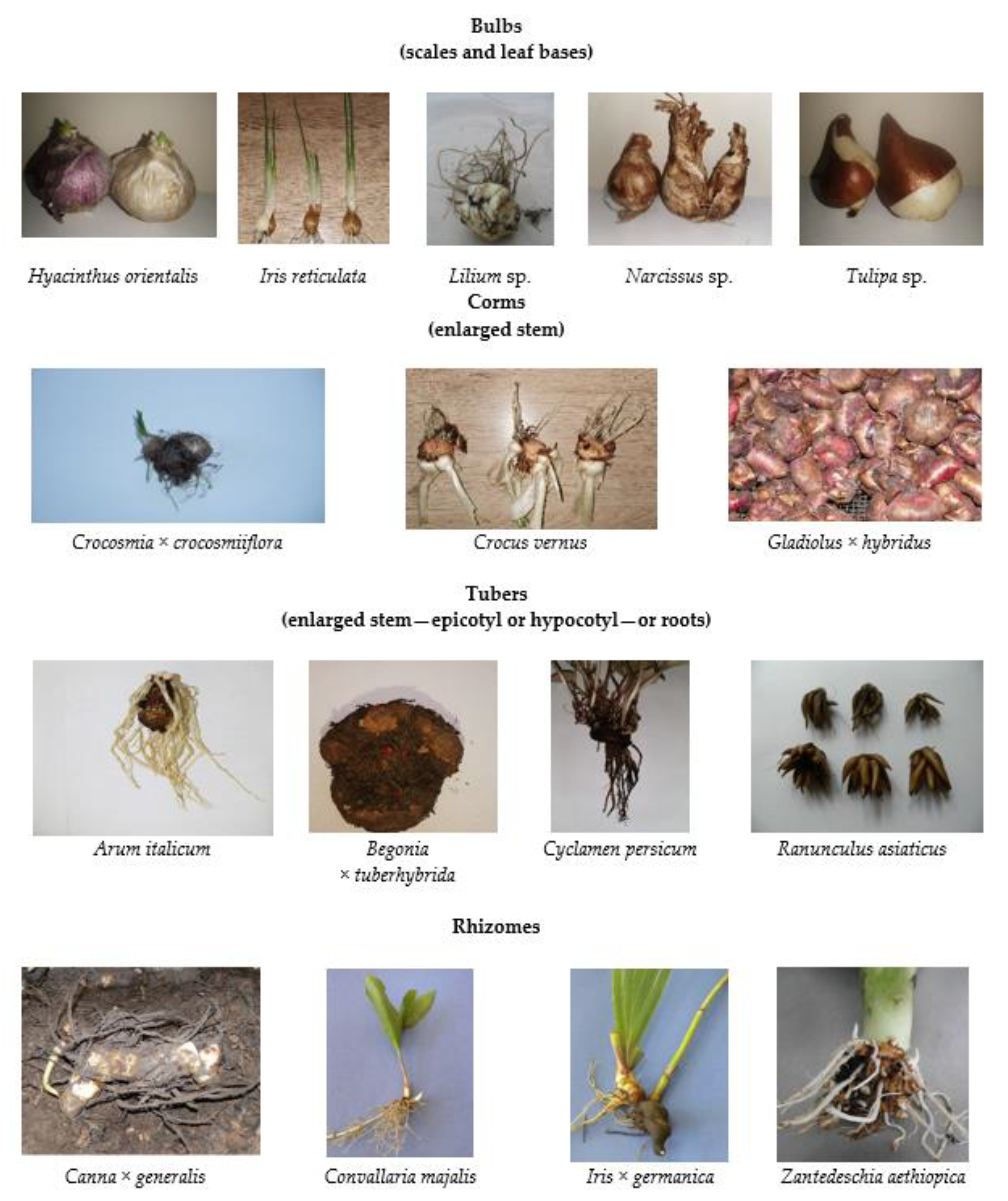
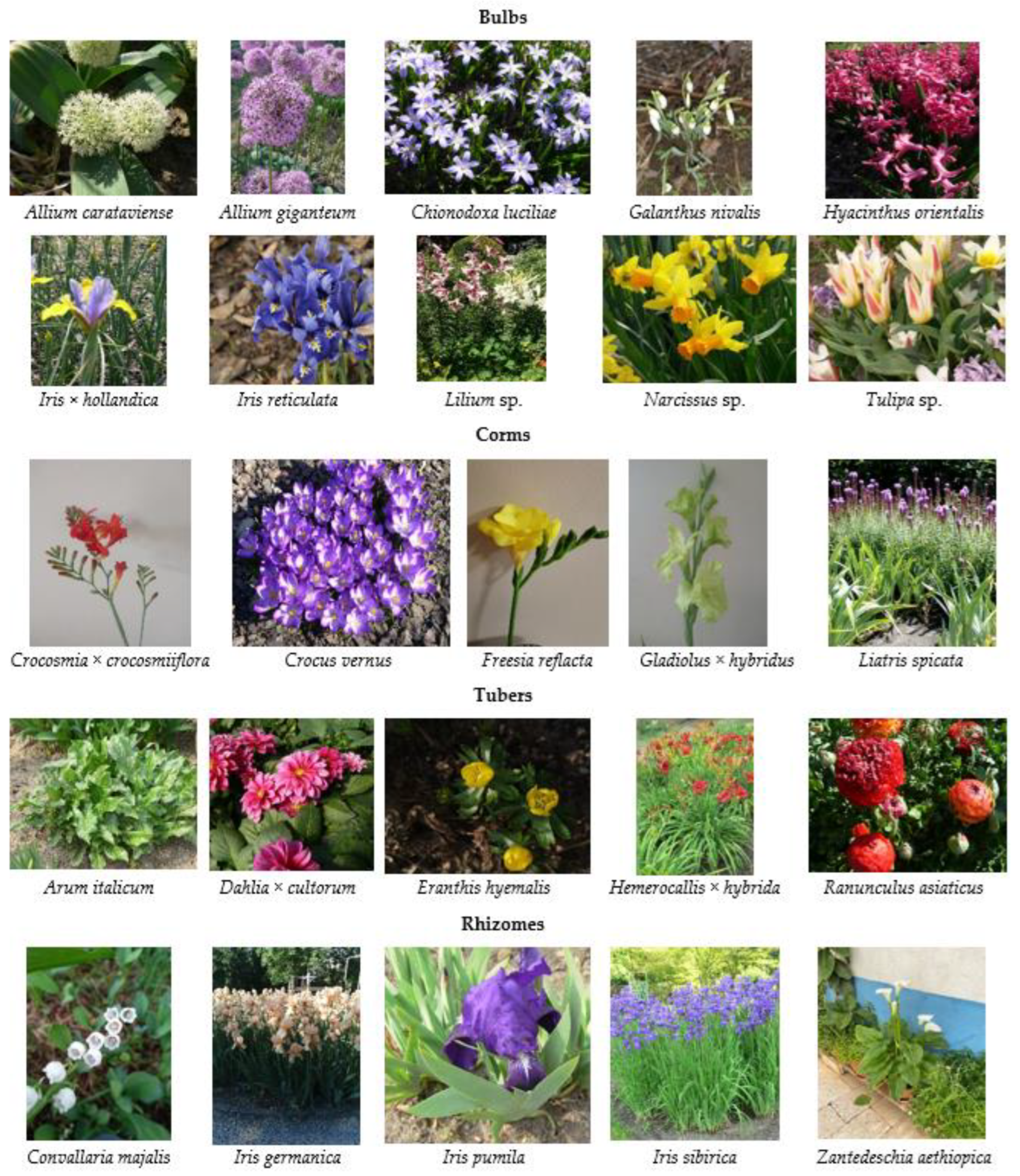
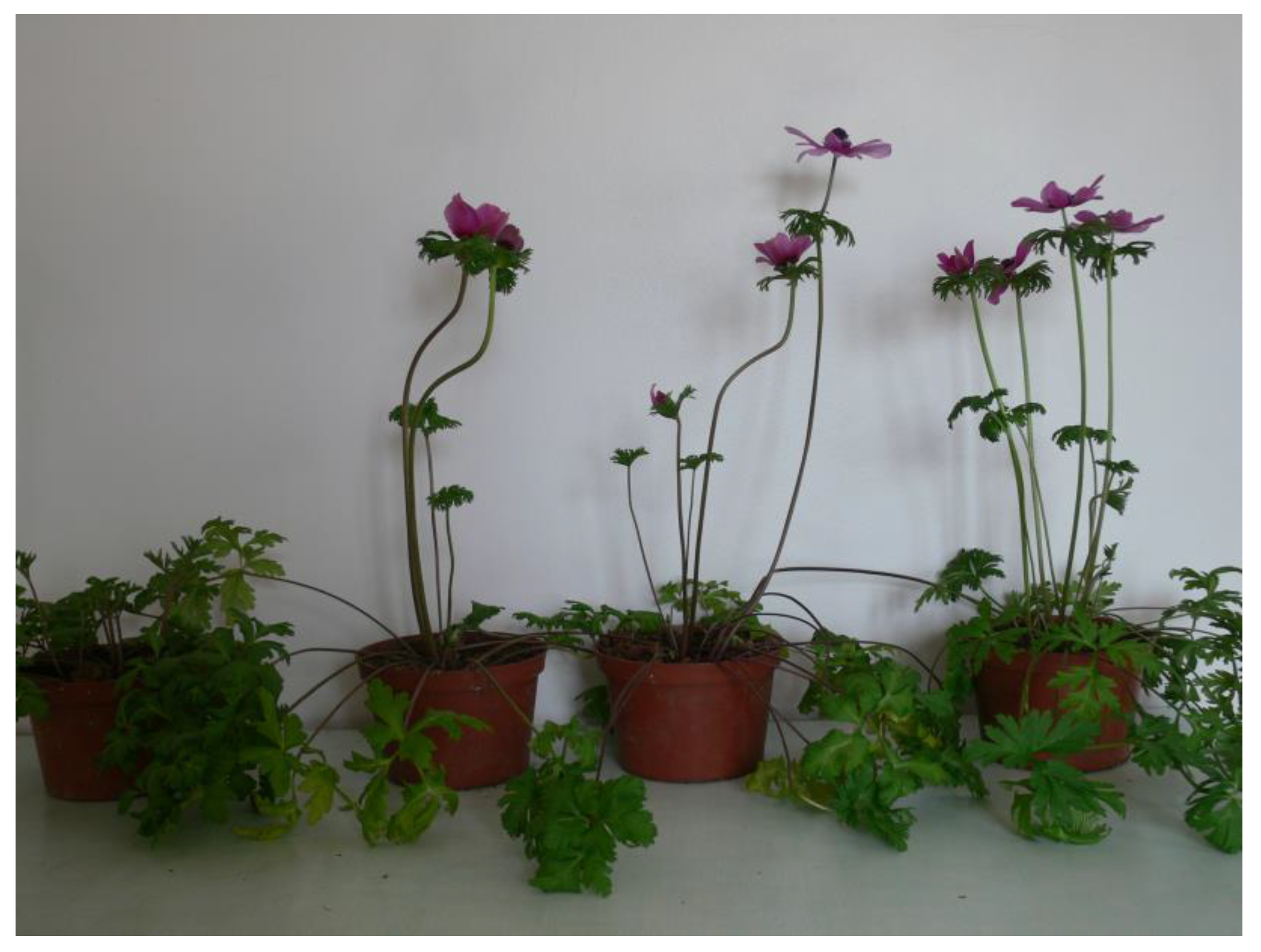
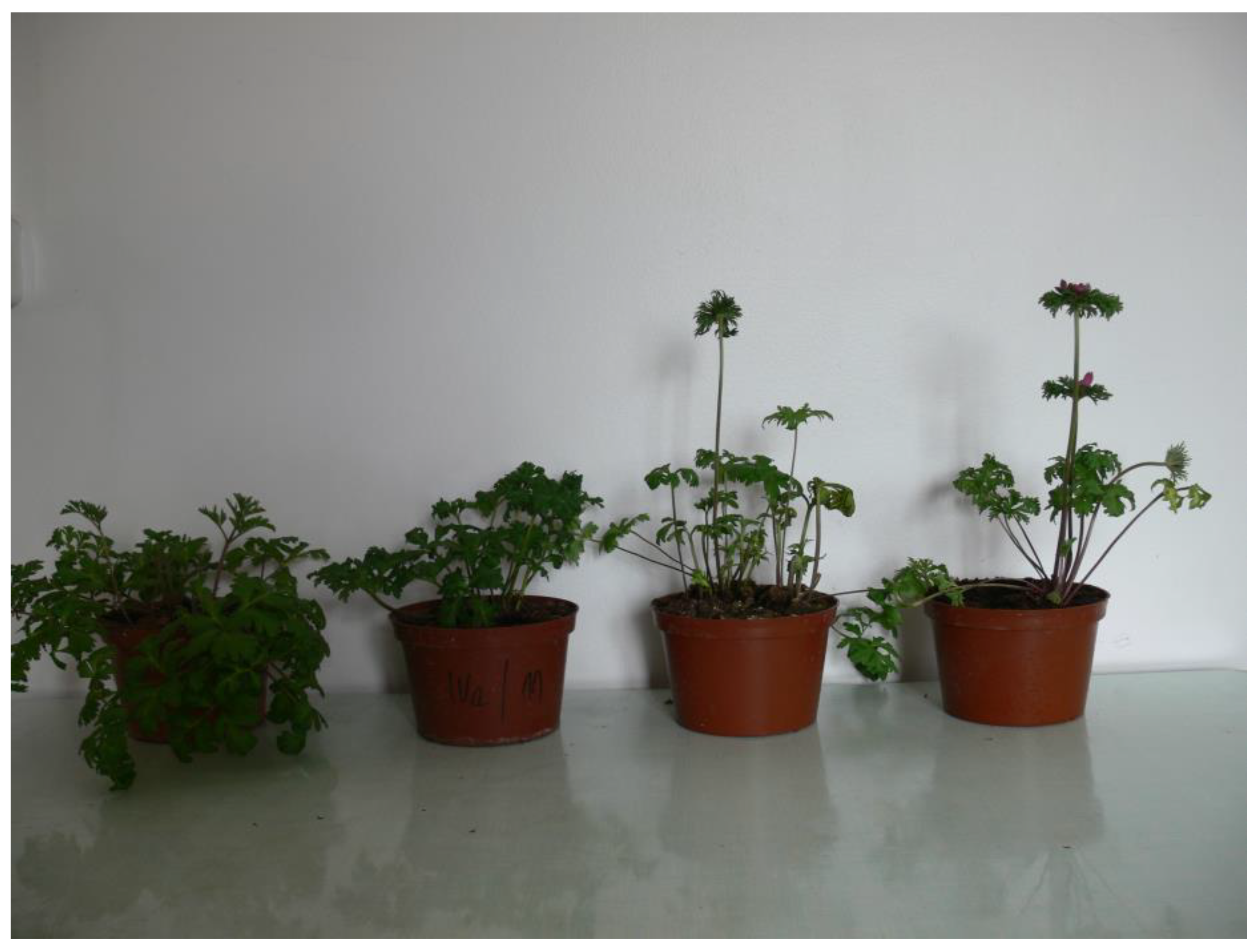
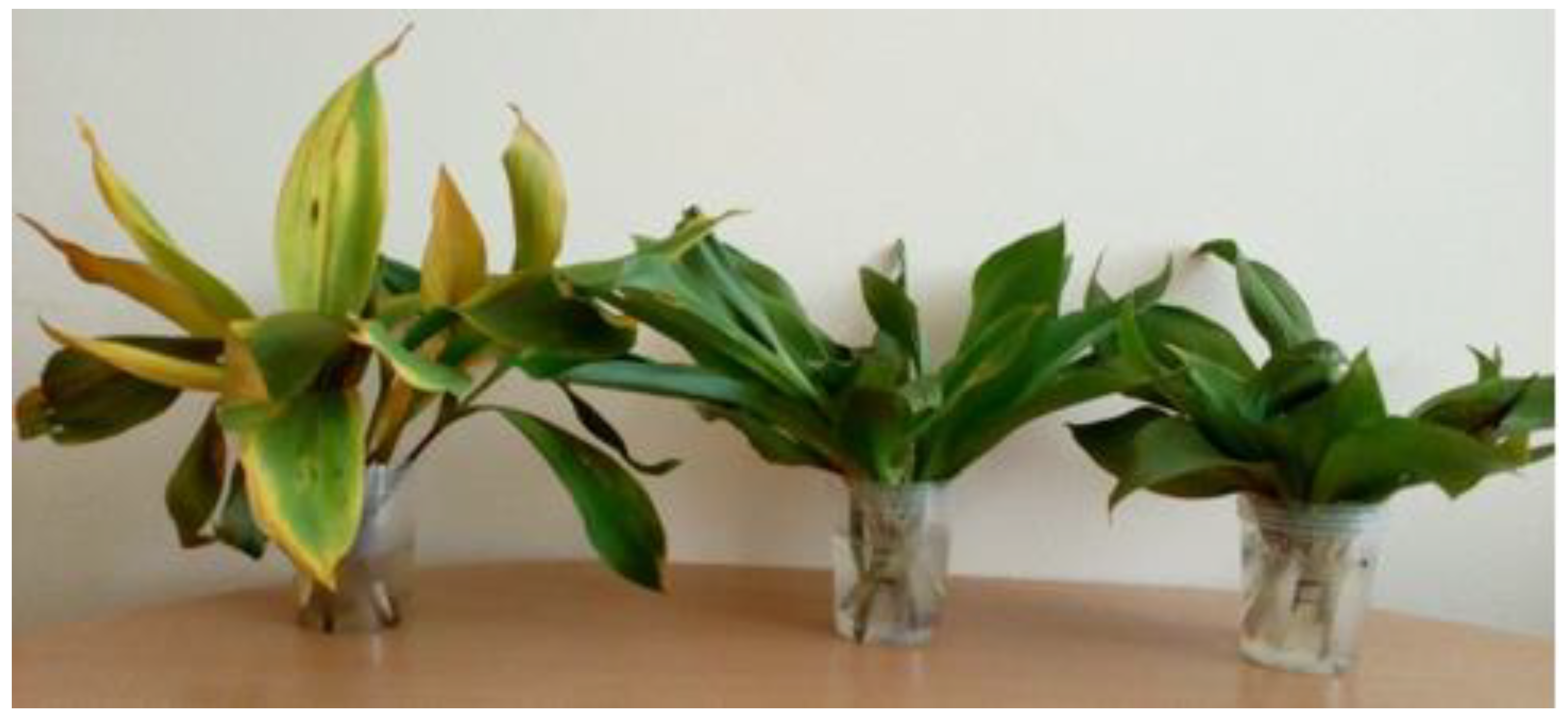
| Species | PGR | Effect | Source |
|---|---|---|---|
| Alstroemeria aurantiaca | GA3 | better vase life of leaves | [46,47,48] |
| Amaryllis belladonna ‘Zephyranthes’ | GA3 | earlier flowering, larger flowers, more leaves, better vase life of flowers | [49] |
| Anemone coronaria | GA3 BA | longer flowering shoots, earlier flowering, more chlorophyll, and carotenoids no effect on flowering intensity, shorter flower stalks, smaller flowers | [50,51,52] [53] |
| Arum italicum | GA3 BA | better vase life of leaves | [53] [54] |
| Convallaria majalis | [Gib][Ach] | better vase life of leaves | [55] |
| Crocosmia × crocosmiiflora | GA3 | more kaempferol, quercetin, quercetin 3-O-glucoside, kaempferol 3-O-rhamnosylglucoside and β-carotene | [56] |
| Cyklamen persicum | GA3 | longer flower stalks, earlier flowering, more flowers | [57,58,59] |
| Freesia reflacta | GA BA | taller plants, more leaves, more inflorescences shoots longer inflorescences, larger leaves | [60] [61] |
| Gladiolus hybridus Gladiolus grandiflorus Gladiolus sp. | GA3 BA IAA NAA | more adventitious corms; shorter spikes and fewer flowers on a short day, but longer spikes and more flowers on a long day earlier and better flowering shorter inflorescence shoots but longer flower clusters and more flowers more adventitious corms | [16,31,62,63,64] [65] [16] [32] [66,67] |
| Hemerocallis × hybrida | MemT MemTR [Chol][Gib] [Q-C2][Gib] [Gib][Ach] | better vase life of leaves | [68] |
| Hippeastrum × hybridum | GA3 | better vase life of leaves | [69] |
| Hyacinthus orientalis | GA3 | intensive growth of leaves, inhibition of the formation of adventitious bulbs | [70,71] |
| Iris × hollandica | GA3 | no impact | [72] |
| Lilium sp. | GA3 | better vase life of leaves | [73] |
| Muscari armeniacum | GA3 | longer leaves and inflorescence stalks | [74] |
| Tulipa sp. | GA3 | longer flower shoots | [75,76] |
| ×Amarine tubergenii ‘Zwanenburg’ | GA3 | more leaves, more bulb weight, more daughter bulbs, better carbon dioxide (CO2) assimilation, more sugars and proteins, earlier flowering, better flowering | [77] |
| Zantedeschia aethiopica | BA GA3 + BA GA3 | more inflorescences better vase life of leaves | [78,79] [80] |
| Zantedeschia with colorful spathes | GA3 BA GA3 + BA BA GA3 MemT MemTR | later flowering, more inflorescences better vase life of flowers better vase life of leaves | [23,25,27,35,81,82,83,84,85] [44] [43,44,86,87] |
Disclaimer/Publisher’s Note: The statements, opinions and data contained in all publications are solely those of the individual author(s) and contributor(s) and not of MDPI and/or the editor(s). MDPI and/or the editor(s) disclaim responsibility for any injury to people or property resulting from any ideas, methods, instructions or products referred to in the content. |
© 2023 by the authors. Licensee MDPI, Basel, Switzerland. This article is an open access article distributed under the terms and conditions of the Creative Commons Attribution (CC BY) license (https://creativecommons.org/licenses/by/4.0/).
Share and Cite
Janowska, B.; Andrzejak, R. Plant Growth Regulators for the Cultivation and Vase Life of Geophyte Flowers and Leaves. Agriculture 2023, 13, 855. https://doi.org/10.3390/agriculture13040855
Janowska B, Andrzejak R. Plant Growth Regulators for the Cultivation and Vase Life of Geophyte Flowers and Leaves. Agriculture. 2023; 13(4):855. https://doi.org/10.3390/agriculture13040855
Chicago/Turabian StyleJanowska, Beata, and Roman Andrzejak. 2023. "Plant Growth Regulators for the Cultivation and Vase Life of Geophyte Flowers and Leaves" Agriculture 13, no. 4: 855. https://doi.org/10.3390/agriculture13040855
APA StyleJanowska, B., & Andrzejak, R. (2023). Plant Growth Regulators for the Cultivation and Vase Life of Geophyte Flowers and Leaves. Agriculture, 13(4), 855. https://doi.org/10.3390/agriculture13040855








